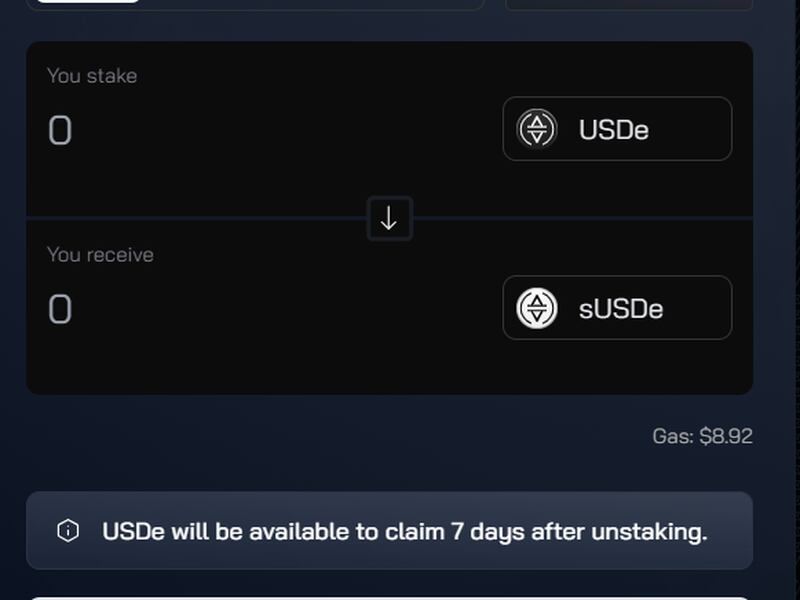DeFi Platform Earning Yield by Shorting Ether Attracts $300M

- More than $287 million of USDe has been minted within days of the platform's launch, with the 27% reward calculated on a rolling seven-day basis and subject to change.
- Users can deposit stablecoins to receive USDe, which can then be staked.
- The yield is generated by staking ether to a validator and earning 5% on the capital, as well as shorting ether futures to capture the funding rate, estimated to be above 20% based on historical modeling.
Decentralized finance platform Ethena attracted massive inflows on its first day amid some criticism around the model it uses to generate an annualized 27% yield to holders of its USDe tokens.
More than $287 million of USDe had been minted as of Tuesday morning, days after the platform went live to the public. The 27% reward is calculated on a seven-day rolling basis and may change each week based on underlying factors.

Users can deposit stablecoins such as tether (USDT), frax (FRAX), dai (DAI), Curve USD (crvUSD) and mkUSD to receive Ethena’s USDe, which can then be staked. Unstaking takes seven days. The staked USDe tokens can be supplied to other DeFi platforms to earn an additional yield.
Ethena calls USDe a synthetic dollar, which largely mimics an algorithmic stablecoin: The tokens have a target peg of $1 that is minted as ether (ETH) tokens are deposited to the platform.
The yield is generated from two sources:
1. Staking ether to a validator and earning 5% on the capital.
2. Shorting ether futures to capture the funding rate, which is estimated to be above 20% as of historical modeling.
This futures mechanism is similar to a “cash and carry" trade, in which a trader takes a long position in an asset while concurrently selling the underlying derivative. Such a trade, in theory, is directionally neutral and earns money from funding payouts instead of the underlying asset’s price movement.
opened twitter and see
— ҈ (@jeff_w1098) February 19, 2024
yall raised a bunch of money
for someone to do cash carry for u?@ethena_labs
can't u just sign up on the exchange and just hedge off on coin margined urself tf
nvm yall need influencers and vcs to tell u what buttons to clickhttps://t.co/vgpGYfpGmQ
While the first-day flows have been significant, some parts of the crypto community say the concept has been tested – and failed to catch on – previously.
“There's been 2 projects that tried this before and both gave up because they lost money due to yields inverting,” said @0xngmi, a co-founder at DeFillama in an X post. “When yields invert you start losing money, and the bigger the stablecoin is the more money it loses.”
Others say the concept could face tests around how its risk is managed.
“While new stablecoin experiments are welcome, there are several parts to Ethena that will likely be challenged, especially regarding its risk management,” Doo Wan Nam, founder of governance research firm Stable Lab, said in a Telegram chat.
Ethena’s head of research, Conor Ryder, addressed some of these concerns in an X post on Monday, stating the protocol had gone live with its parameters based on historical testing that did not present far-fetched risks.
A lot of new eyes on Ethena today and people are right to point out the risks involved
— Conor Ryder (@ConorRyder) February 19, 2024
I wanted to take a sec to highlight some of the extensive work we've done surrounding the risks of the design, and specifically addressing funding risk
Before I get into the meat and veg… pic.twitter.com/zfuWMljkSB
Ryder said that because demand for going long on ether is currently high, the futures rates for shorting the cryptocurrency are expected to remain high.
“There is a clear demand in crypto to go long with leverage. Deep pools of capital are unwilling to lend the capital on the short side of that long leverage,” he said. “Negative funding rates are a feature, rather than a bug of the system. USDe has been built with negative funding in mind.
Ethena’s models have determined that $20 million per $1 billion of USDe would help survive “almost all bearish forecasts of funding rates, Ryder said, and the majority of Ethena’s $14 million funding round will be allocated toward an initial insurance fund of $20 million.
CORRECTION (Feb. 20, 10:46 UTC): Corrects to say inflows from the first few days, not the first day.








